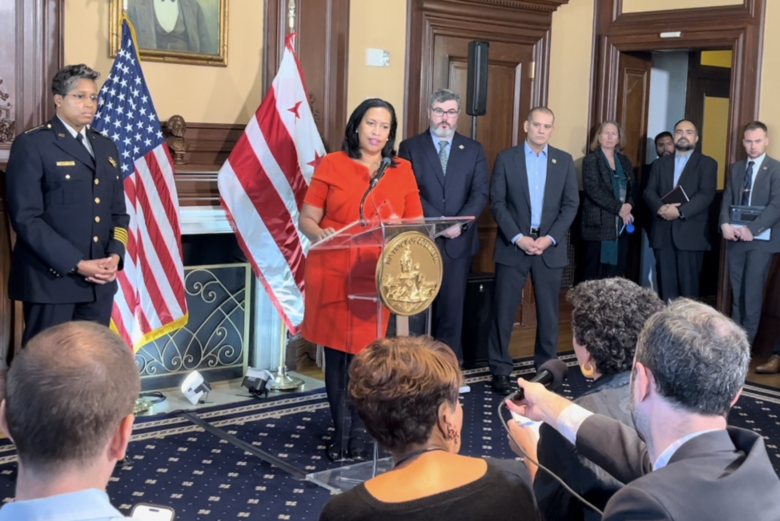New Mexico
Townsend’s solitaire has found its spot in New Mexico

New Mexico
New Mexico secretary of state says she's experiencing harassment after the election
SANTA FE, N.M. (AP) — New Mexico’s top elections regulator said Tuesday that she has been the target of harassing and threatening comments on social media after affirming President-elect Donald Trump’s national election victory in an attempt to halt conspiracy theories.
New Mexico Secretary of State Maggie Toulouse Oliver shared her concerns as she briefed a legislative panel about administration of the general election and progress toward certifying the vote tally amid a surge in same-day voter registration. She said she plans to contact law enforcement about the threats.
“I am currently experiencing threats, harassment — from even some members of this committee — online,” said Toulouse Oliver, a Democrat who has been subject repeatedly to threats in the past. “And I want to say that thankfully we have a law in place that protects me from this behavior.”
A 2023 state law made it a fourth-degree felony to intimidate a state or local election official.
After the hearing, Toulouse Oliver said she attempted to “nip some emerging conspiracy theories in the bud” with a post on the social platform X that stated Trump had won outright while acknowledging that some states were still counting votes and fewer voters showed up to the polls this year. In response, she said she was accused of committing treason and told she was “in the crosshairs.”
Toulouse Oliver later switched off public access to that X account — used for political and private conversations — and said she was gathering information to refer the matter to state police and the state attorney general. An official X account for the secretary of state’s office remains public.
Toulouse Oliver accused Republican state Rep. John Block, of Alamogordo, of egging on and “helping to foment the anger and some of the nasty comments online.” She did not cite specific posts.
Block said he too has been a victim on online harassment and “that has no place in this (legislative) body or anywhere else.”
“If it gets to violent threats like you described that you got, I apologize that that is happening to you,” Block said during the committee hearing.
Toulouse Oliver told lawmakers at the hearing that she’ll advocate for new security measures for state and local election workers to keep their home addresses confidential on government websites. A law enacted in 2023 offers that confidentiality to elected and appointed public officials.
Trump lost the general election for president in New Mexico to Democratic nominee and Vice President Kamala Harris. Democratic candidates were reelected to the state’s three congressional seats and a U.S. Senate seat, while Republicans gained a few seats in legislative races but remain in the state House and Senate minorities.
More than 52,000 people used same-day registration procedures to vote in New Mexico.
New Mexico
No. 15 Texas A&M Aggies Preview: New Mexico State Aggies

College Station will feature an Aggie-filled affair later this fall when Texas A&M hosts New Mexico State at Kyle Field on Nov. 16 for the second-ever meeting between the two programs.
In the first meeting, A&M took down NMSU with ease in a 52-10 blowout win during the 2016 season. No. 9 Texas A&M used two punt return touchdowns and receiving score from Christian Kirk along with a steady performance from quarterback Trevor Knight.
A&M would go on to lose to unranked SEC opponents during its next two games and dropped out of the top 10. The Aggies and first-year head coach Mike Elko will be hoping that history won’t repeat itself eight years later, but that’s easier said than done.
New Mexico State is coming off of arguably the best season in program history, as the Aggies posted 10 wins for the first time since going 11-0 in 1960. The team made it to back-to-back bowl games under head coach Jerry Kill, but he shockingly resigned at the end of last season. Former UNLV coach Tony Sanchez has since replaced him.
A&M fans haven’t stopped hearing about the massive upset loss to Appalachian State two seasons ago. Though this is a different team headed into the 2024 campaign, Elko might want to roll the tape of that game before facing New Mexico State to ensure his team doesn’t overlook the visiting Aggies.
2024 Record: 2-7
Head coach: Tony Sanchez
Offensive Leaders:
Passing: QB Parker Awad
2024 stats: 40 of 93 passes completed, 518 yards, four touchdowns, three interceptions.
Rushing: RB Seth McGowan
2024 stats: 120 carries for 636 yards and three touchdowns, three receptions for 14 yards and a receiving touchdown.
Receiving: WR T.J. Pride
2024 stats: 23 receptions, 238 yards, one touchdown
Defensive Leaders:
Tackles: LB Tyler Martinez, 71
Interceptions: DB Josiah Cox, 2
Sacks: DE Kale Edwards, 4.0
Join the Community:
You can follow us for future coverage by subscribing to our newsletter here. Also, be sure to like us on Facebook @AllAggiesOnSI & follow us on Twitter at @TAMUAggiesSI
MORE TEXAS A&M AGGIES NEWS:
Texas A&M Aggies Open As Major Favorites vs. New Mexico State
How Does Mike Elko Prepare His Players For Noise at Kyle Field?
‘Never Play Like That Again!’ Mike Elko Gets Honest About Texas A&M Aggies
Texas A&M Aggies’ Mike Elko Has A Message For Shemar Turner About Penalties
Texas A&M Aggies Coach Mike Elko Named To Bear Bryant Coach Of The Year Watchlist
New Mexico
Zombie birds? New Mexico researchers develop wildlife observation drones from dead birds

The research team at New Mexico Tech has constructed and tested pheasant, mallard duck and pigeon drones and robots. The lead researcher wants them for wildlife monitoring but uses could vary.
Zombie duck drones monitor fellow wildlife
New Mexico Tech are fitting bird carcasses with drone technology to monitor wildlife and bird populations.
Zombie birds are no longer part of post-apocalyptic fiction; they may soon be among us. But in their newfound life, the birds aren’t looking for brains. They’re being used to further wildlife research.
Researchers at the New Mexico Tech Institute of Mining and Technology in Socorro have spent the past two years developing drones and robots from the bodies of dead birds. Still in testing, the animatronic birds may be used to study avian formations, coloration and communication, in addition to other natural ecosystems.
These bird-like drones could solve some issues that wildlife researchers have experienced with traditional drones, said Mostafa Hassanalian, lead researcher and mechanical engineering professor at New Mexico Tech.
“Sometimes, you get a bird strike. The birds attack your drone. Your drone gets damaged and at the same time, the birds get hurt or they might be killed,” Hassanalian said. “Drones carry lots of noise. For example, if you are monitoring a herd of elephants in Africa for wildlife monitoring, they carry lots of noise and the animals would be scared and scatter.”
By creating “nature-inspired robotic systems,” Hassanalian hopes researchers can find more success in studying wildlife.
Here’s what you need to know, including whether the bird drones could be used outside of the animal kingdom.
Different birds for different purposes
Hassanalian and his students have worked with the bodies of three different types of birds throughout their research.
The first is a pheasant. Using a real taxidermy pheasant head and pheasant wings, the research team tested the creation of a drone with flapping wings. The purpose was to create a drone that could more naturally blend in with other pheasants for wildlife monitoring.
The team studied the wings of pheasants, flapping patterns, thrust and lift forces, among other characteristics to create a realistic drone.
The research team has also worked with dead mallard ducks to create two different types of robots − a swimming robot and a flying drone. The latter was designed and tested similarly to the pheasant, while the former required some new research and testing.
Rather than focusing on recreating flapping wings, the focus of the swimming duck robot was recreating feet that accurately replicated a duck’s that can glide through the water and dive down. Similar to airborne birds, the swimming duck robot could be used to monitor aquatic wildlife.
The latest of the research team’s work centers around stationary pigeons.
“They have a camera in the neck and this can basically do real-time video or broadcasting,” Hassanalian told USA TODAY. “Say you go in a national park and you want to study the wildlife and you want to have a stationary platform − there are some drones probably being used for that … You can put one of (these) there (in a tree) with the camera. It’s not distracting to the other birds that are around and then you can basically record the wildlife.”
Ultimately, Hassanalian said he would like to create a bird robot that can fly, swim and perch.
How do other birds react to the drones, robots?
While the research team has conducted meticulous research in order to accurately recreate different birds, in actuality, they don’t yet know how other birds would react to them. So far, the research team has only tested the drones and robots in controlled environments on New Mexico Tech’s campus, Hassanalian said.
“We know there’s a challenge that they might be attacked by other birds, but I mean, that’s a part of nature,” Hassanalian said with a laugh.
Hassanalian said his research team is looking at obtaining permission to fly the drones among real birds in non-simulated environments.
Where do the dead birds come from?
All of the birds that Hassanalian and his team use are naturally dead.
“They have all been ‘taxidermied’ by certified taxidermists. We purchase them and try to play with them,” he said. “We’re not asking a taxidermist to kill a bird and then do the taxidermy and give it to us.”
Surveillance potential
Hassanalian and his research team are only interested in studying the use of their bird-like drones to aid wildlife observation right now, but he recognizes that the technology could be used for surveillance, too.
“For future direction … types of taxidermy bird drones can be integrated for protecting the border,” Hassanalian said. “That’s another potential application. We have not been looking at that, but I’m just talking about the potential application.”
Throughout work on this project, Hassanalian has been made aware of concerns related to security and how the bird-like drones could be used for spying.
Several bird-centric conspiracy theories, like Birds Aren’t Real, have grown in popularity over the years, but Hassanalian said his research isn’t associated with any of them. Gaining traction around the COVID-19 pandemic, Birds Aren’t Real claimed that all real-life birds were replaced with “surveillance drones” in the 20th century. Despite its large following, Birds Aren’t Real was not a real conspiracy, but rather an online joke.
“I wasn’t aware of that conspiracy theory until I did this project,” Hassanalian said. “The possibility of any technology being repurposed in unintended ways is a valid concern. While our research aims to support scientific and environmental initiatives, we recognize that any technology could be misused if it falls into the wrong hands. This is why it is always crucial to have appropriate regulations, ethical guidelines and public dialogue around the development and use of drones.”
When it comes to the bird drones being used for spying, Hassanalian said it is not something he or his research team supports.
What’s next?
In addition to his work with bird drones, Hassanalian is researching the creation and implementation of dandelion-inspired drones to assist in seed dispersal.
“Bees, they are in edangered … they have a very important role in seed dispersals,” he said. “The dandelion drone we are developing, they also can be used for dispersing the seeds and bird drones can actually carry the dandelion drones in much more nature-friendly ways for seed dispersals.”
Though this implementation is still a ways out from being a reality, this research could have an impact on bee endangerment and pollination in the natural world.
Hassanalian said he also has an interest in creating and testing reptile and amphibian drones, such as lizards, frogs and snakes.
This story was updated to correct a spelling error.
Greta Cross is a national trending reporter at USA TODAY. Follow her on X and Instagram @gretalcross. Story idea? Email her at gcross@gannett.com.
-

 Culture1 week ago
Culture1 week agoTry This Quiz on Books That Were Made Into Great Space Movies
-

 Health5 days ago
Health5 days agoLose Weight Without the Gym? Try These Easy Lifestyle Hacks
-

 Culture5 days ago
Culture5 days agoThe NFL is heading to Germany – and the country has fallen for American football
-

 Business4 days ago
Business4 days agoRef needs glasses? Not anymore. Lasik company offers free procedures for referees
-
/cdn.vox-cdn.com/uploads/chorus_asset/file/25538361/247196_Echo_Spot_Review_8A0A1511_CVirginia.jpg)
/cdn.vox-cdn.com/uploads/chorus_asset/file/25538361/247196_Echo_Spot_Review_8A0A1511_CVirginia.jpg) Technology1 week ago
Technology1 week agoAmazon’s Echo Spot alarm clock is on sale with a free color smart bulb
-

 Sports4 days ago
Sports4 days agoAll-Free-Agent Team: Closers and corner outfielders aplenty, harder to fill up the middle
-

 News1 day ago
News1 day agoHerbert Smith Freehills to merge with US-based law firm Kramer Levin
-
/cdn.vox-cdn.com/uploads/chorus_asset/file/25724877/Super_Nintendo_World.png)
/cdn.vox-cdn.com/uploads/chorus_asset/file/25724877/Super_Nintendo_World.png) Technology2 days ago
Technology2 days agoThe next Nintendo Direct is all about Super Nintendo World’s Donkey Kong Country





















